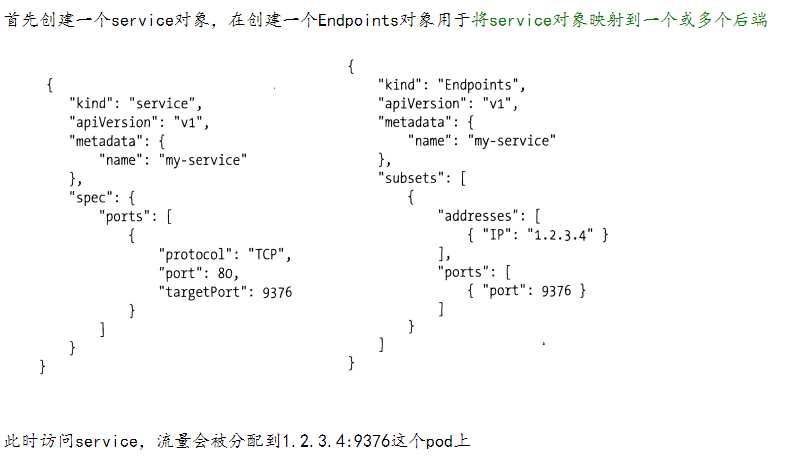标签:负载 cto mes 负载均衡 健康 必须 请求 init 内容
service是k8s最核心的概念。通过创建service,可以为一组具有相同功能的容器应用提供一个统一的入口地址,并且将请求负载分发到后端的各个容器应用上去
ymal格式的service定义文件的完整内容如下
apiVersion: v1 #必须 kind: Service #必须 matadata: #必须,元数据 name: string #必须,service的名称 namespace: string #非必须,指定的namespace名称,与rc在同一个namespace即可 labels: #非必须,service的标签 - name: string annotations: #非必须,service的注解属性信息 - name: string spec: #必须,详细描述 selector: [] #必须,lable selector设置,选择具有执行lable标签的pod作为管理范文 type: string #必须,service的类型,指定service的访问方式,默认为cluster ip,用于k8s内部的pod访问, node上的kube-proxy通过设置iptables 转发 nodePort,使用 宿主机的端口,是能够访问各node的外部客户通过node的ip地址和端口就能访问服务
loadbalancer: 使用外接负载均衡完成服务到负载的分发,需要在spec.status.loadBalancer字段指定负载均衡器的ip,并同时定义nodePort和clusterIP
clusterIP: string #非必须,虚拟服务器ip地址 sessionAffinity: string #非必须,是否支持session,可选值为cluster ip ports: #端口 - name: string #端口名称 protocol: string #协议类型 port: int #服务监听的端口号,service clusterip的端口 targetPort: int #需要转发到后端pod的端口 nodePort: int #container port 映射到宿主机的端口 status: #当type 为loadBalancer时,说这负载均衡的地址 loadBalancer: ingress: #外部负载均衡 ip: string #负载均衡器的ip地址 hostname: string #外部负载均衡的主机名
创建一个包含两个tomcat副本rc,并为其创建一个service
[root@k8s_master tomcat-service-rc]# cat webapp-rc.yaml apiVersion: v1 kind: ReplicationController metadata: name: webapp labels: name: webapp spec: replicas: 2 selector: name: webapp template: metadata: labels: name: webapp spec: containers: - name: webapp image: tomcat imagePullPolicy: IfNotPresent ports: - containerPort: 8080 [root@k8s_master tomcat-service-rc]# kubectl create -f webapp-rc.yaml #创建service并查看 [root@k8s_master tomcat-service-rc]# kubectl expose rc webapp #通过命令行快速创建,一般不采用 service "webapp" exposed [root@k8s_master tomcat-service-rc]# kubectl get svc NAME CLUSTER-IP EXTERNAL-IP PORT(S) AGE kubernetes 10.254.0.1 <none> 443/TCP 272d webapp 10.254.185.154 <none> 8080/TCP 12s [root@k8s_master tomcat-service-rc]# kubectl describe svc webapp Name: webapp Namespace: default Labels: name=webapp Selector: name=webapp Type: ClusterIP IP: 10.254.185.154 Port: <unset> 8080/TCP Endpoints: 10.1.20.2:8080,10.1.34.2:8080 Session Affinity: None No events. 此时在两个node 上通过clusterip:8080 均可以访问 tomcat服务,service将请求分发到两台容器上,默认采用了RoundRobin(轮训rr)模式,
SessionAffinity : 基于客户端ip地址进行会话保持的模式,即第一次访问哪个pod,以后的请求都访问这个pod
#通过yaml文件的方式创建自定义的service [root@k8s_master tomcat-service-rc]# cat webapp-service.yaml apiVersion: v1 kind: Service metadata: name: webapp1 labels: name: webapp spec: ports: - port: 8081 targetPort: 8081 selector: name: webapp [root@k8s_master tomcat-service-rc]# kubectl create -f webapp-service.yaml #查看两个service [root@k8s_master tomcat-service-rc]# kubectl describe svc webapp webapp1 Name: webapp Namespace: default Labels: name=webapp Selector: name=webapp Type: ClusterIP IP: 10.254.185.154 Port: <unset> 8080/TCP Endpoints: 10.1.20.2:8080,10.1.34.2:8080 Session Affinity: None No events. Name: webapp1 Namespace: default Labels: name=webapp Selector: name=webapp Type: ClusterIP IP: 10.254.179.138 Port: <unset> 8081/TCP Endpoints: 10.1.20.2:8080,10.1.34.2:8080 Session Affinity: None No events.
创建一个不带标签选择器的service,即无法选择后端pod,系统不会自动创建endpoint,因此需要手动创建一个和该service同名的endpoint,用于指向实际的后端访问地址,如下:

pod和service是集群内的虚拟概念,所有集群外的客户端系统无法通过pod的ip地址或者service的虚拟ip地址和端口访问到他们,为了让客户端能够访问到他们,需要将pod或者service的地址和端口映射到宿主机。
①、将容器应用的端口映射到物理机
容器级别映射
apiVersion: v1 kind: Pod metadata: name: webapp labels: name: webapp spec: containers: - name: webapp image: tomcat ports: - containerPort: 8080 #容器端口 hostPort: 8081 #宿主机端口(物理机)
pod级别的设置,hostNetwork=true,该pod中所有容器的端口号都被直接映射到物理机上,使用此设置的时候要注意,如果该容器的ports定义部分不指定hostPort(物理机端口),则默认hostPort等于containerPort,如果指定了hostPort,则hostPort必须等于containerPort的值
apiVersion: v1 kind: Pod metadata: name: webapp labels: name: webapp spec: hostNetwork: true containers: - name: webapp image: tomcat ports: - containerPort: 8080
此时会将tomcat容器运行的所有端口映射到创建pod的物理机上
②、将service的端口号映射到物理机
[root@k8s_master tomcat-service-rc]# cat webapp-rc.yaml #创建一个rc apiVersion: v1 kind: ReplicationController metadata: name: webapp labels: name: webapp spec: replicas: 2 selector: name: webapp template: metadata: labels: name: webapp spec: containers: - name: webapp image: tomcat imagePullPolicy: IfNotPresent ports: - containerPort: 8080 [root@k8s_master tomcat-service-rc]# cat webapp-service.yaml apiVersion: v1 kind: Service metadata: name: webapp labels: name: webapp spec: type: NodePort ports: - port: 8080 #service虚拟端口 targetPort: 8080 #容器端口 nodePort: 30001 #各node节点开启的端口,端口范围 3000-32767 selector: name: webapp
查看
[root@k8s_master tomcat-service-rc]# kubectl get svc -o wide NAME CLUSTER-IP EXTERNAL-IP PORT(S) AGE SELECTOR kubernetes 10.254.0.1 <none> 443/TCP 273d <none> webapp 10.254.44.190 <nodes> 8080:30001/TCP 24s name=webapp
apiVersion: v1 kind: Service metadata: name: my-webapp labels: name: my-webapp spec: ports: - protocol: TCP port: 8080 targetPort: 8080 nodePort: 30001 clusterIP: 10.254.44.191 LoadBalancerIP: 10.20.203.100 type: LoadBalancer selector: name: webapp status: LoadBalancer: ingress: - ip: 10.20.203.100
为了实现通过服务的名字在集群内部进行服务的相互访问,需要创建虚拟DNS服务来完成服务名到clusterip的解析
k8s提供的虚拟dns服务名为skydns,由四个组件构成
工作原理解析
具体搭建信息看 kubernetes DNS
service的表现形式为IP.Port,工作在tcp/ip层,对于基于http的服务来说,不同的url地址要对应到不同的后端服务或者虚拟服务器上去,这些要求通过service机制无法实现,k8s 1.1以后增加的ingress 可以将不同的url访问请求转发到后端不同的service,实现http的业务路由机制,在k8s中需要ingress的定义和ingress controller的定义结合起来,才能形成完整的http负载分发能力
示例: 暂时略过
标签:负载 cto mes 负载均衡 健康 必须 请求 init 内容
原文地址:https://www.cnblogs.com/FRESHMANS/p/9342793.html